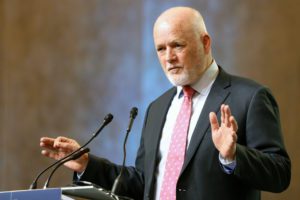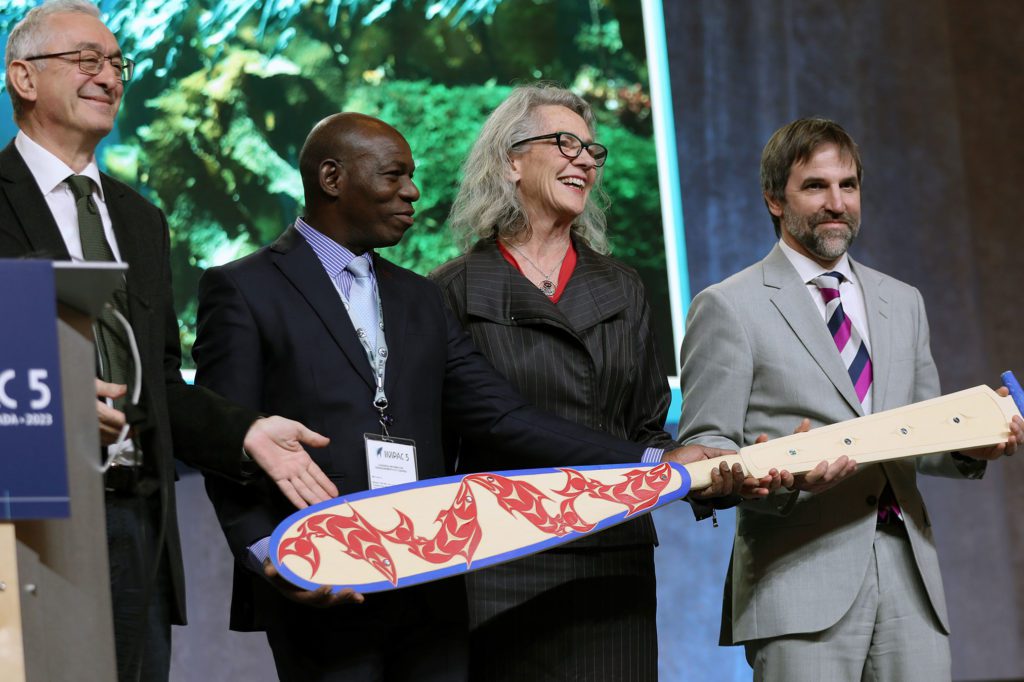Takeaways from IMPAC5 – the 5th International Marine Protected Areas Congress, Canada.
Syexwáliya Ann Whonnock, Squamish Nation elected counsilor - IMPAC5. Photo by IISD/ENB | Anastasia Rodopoulou.
The congress embraced relevant topics such as communities, youth and indigenous peoples´ involvement, sustainable financing for MPAs, sustainable fisheries and several aspects on MPA governance and management.
From February 3rd to the 9th, the 5th International Marine Protected Areas Congress (IMPAC5) opened its doors in Vancouver, Canada. This global forum aims to engage ocean conservation professionals, youth delegates, Indigenous Peoples, authority representatives and other stakeholders from all over the world to exchange knowledge, experiences and best practices to strengthen the conservation of marine biodiversity and the protection of the ocean.
Hosted in the traditional territories of the First Nations’ Squamish, Musqueam, and Tsleil-Waututh Nations, the congress had a strong presence of First Nations and Inuit representatives, who reminded us all that Canada is an ocean nation, with the longest coastline in the world and that protecting of marine ecosystems is key for the nation’s survival. During the opening and in this same line of thought, it was emphasized the vital role that oceans play in people’s lives, both for the services they provide to our society (1) and the deep connection that exists between the ocean and Canada’s culture and economy (2).
The opening ceremony also highlighted that the congress is an official activity of the UN Decade of Ocean Science for Sustainable Development and a contributing act for the implementation of the recently adopted Kunming-Montreal Global Biodiversity Framework.
The Kunming-Montreal Global Biodiversity Framework
The recently agreed upon Kunming-Montreal Global Biodiversity Framework is an important step for global conservation. This framework aims to halt and reverse biodiversity loss and covers marine areas within national jurisdiction and, in the congress, it was recognised as “the most important universal agreement we have”, while it was underscored that there cannot be a healthy planet without a healthy Ocean, and that its health is in decline (3).

Peter Thomson, UN Secretary-General’s Special Envoy for the Ocean – IMPAC5. Photo by IISD/ENB | Anastasia Rodopoulou.
One particular target includes the commitment to protect 30% of the oceans by 2030 (also known as 30×30). However, this is an incredible challenge, as it implies expanding to almost triple the current Marine Protected Areas (MPAs) in the next seven years (4).
In this line, a specific discussion took place on the efficacy of a 30% area target based on a case study on MPAs in the German North Sea, underlining that each MPA is subject to different stressors and therefore requires specific management solutions (5). However, a reminder of our existing lack of knowledge and understanding of extense areas of the oceans such as the high seas and the deep seas, and the necessity to create MPAs on these areas and around the Antarctic, was also presented together with a call to think beyond the 30×30, as protecting 30% of the planet is not going to solve all the world’s problems (6).
Community involvement – Empowering communities to lead the way

Sylvia Earle, Founder and Co-Chair, Mission Blue 1 – IMPAC5. Photo by IISD/ENB | Anastasia Rodopoulou.
Local communities, specifically indigenous communities as the hosts of the land on which the congress took place, were undoubtfully another key topic during the congress. Both local communities and small-scale fisheries have a key role in leading the way on environmental stewardship and marine conservation (7) and it is crucial to incorporate their perspectives and knowledge (8).
The benefits of empowering communities to participate and collaborate in the conservation of resources and livelihoods, as well as to achieve a sustainable management, were also presented through examples from Myanmar (9) and Tanzania (10). Other interesting cases about community led initiatives were presented: A community led coral conservation and restoration activities that include the certification of community coral gardeners in San Andrés, Colombia (11); A monitoring and reporting framework on a marine reserve developed in cooperation with indigenous people in New Zealand (12); An ongoing process to develop a community-based MPA in this southern Chilean archipelago (13).
Sustainable Finances and Sustainable Tourism in MPAs
The integration of science and community-based approaches were also identified as a solution to improve the management and financial sustainability of the MPAs (14). Other examples of blue finance solutions were presented from Onnason, Okinawa, on a mozuku seaweed farming and coral plantation (15).
Sustainable Tourism was also integrated in the conversations. From a financial point of view, an example on the development of a business model based on raising revenue from sustainable tourism in order to support the budget of the Turneffe Atoll Marine Reserve was presented (16). As a counterpart, the efforts undertook to limit the negative to regulate diving tourism in Karimunjawa National Park in the Java Seas, Indonesia, were explained and reminded the participants the negative impacts that tourism activities can pose to marine ecosystems (17).
Challenges in MPA Management and Governance
Some interesting reflections on MPA management and its challenges were brought to the discussion. It is noteworthy to mention the presentations submitted about Gwaii Haanas National Park in Canada, covering an overview of its history over the last 30 years and its main challenges and solutions. In this regard, some conclusions on research studies on measuring co-development of governance indicators to support the implementation of a landsea-people plan in this Park were exposed (18).
Other factors underpinning MPA management were identified as social, economic and ecological elements, as explained in a case study on the management of San Antonio MPA (19). Likewise, , social acceptance of MPAs was identified as another barrier in its implementation and, based on the research outcomes on a generic MPA model, it was concluded that many times the opposition to MPAs is not against conservation, but rather the design and implementation model used (20).
On the other hand, Transboundary Cooperation was also present in the discussion with an example on Transboundary Protected Areas management in the Eastern Tropical Pacific in which the importance of enabling the harmonization of different legal, political, and cultural systems and the necessity to develop of a stronger legal framework for “ecological connectivity” were underscored (21).
Another case study in this line was brought on the work of a civil society network for the conservation of the Patagonian Sea, the challenges they face, and how views should be standardized between decision-makers of different countries to reach effective protection when management extends beyond country boundaries (22).

L-R: Bruno Oberle, Director-General, International Union for Conservation of Nature, Mamadou Sidibé, Director of Community Marine Protected Areas, Senegal, Joyce Murray, Minister of Fisheries, Oceans, and Canadian Coast Guard, and Steven Guilbeault, Minister of Environment and Climate Change, Canada – IMPAC5. Photo by IISD/ENB | Anastasia Rodopoulou.
The importance of Other Effective area-based Conservation Measures (OECMs)
As it was underscored during the congress, OECMs present a unique opportunity for stakeholders to get involved in conservation measures. In this regard a case study on the Baltic Sea in relation to the role of the Regional Sea Conventions, highlighting the need of a cross-sectorial approach to interpret the OECM criteria, was presented (23).
Additionally, reflections on the need to bring the socio-economic sectors into the conservation discussion, to clarify to all stakeholders the differences between MPAs and OECMs (24), the necessity of a clearer understanding of the identification process of OECMs (25) and the facilitating role that NGOs can have were also made (26).
Youth involvement

Sean Russell, IMPAC5 Young Professionals Committee – IMPAC5. Photo by IISD/ENB | Anastasia Rodopoulou.
Youth and their involvement in marine conservation was also one of the topics that stood out during the conference and an IMPAC5 Youth Call to Action was presented during the congress, advocating for a set of youth-determined priorities (27).
Furthermore, the work carried out by Connect to Protect initiative which aims to build a digital community and encourage youth leaders to join the GenSea network to collaborate and nurture a community of youth ocean advocates was exposed (28). Panellists were also invited to reflect on several questions encompassing empowering youth in organizations and hiring them (29).
Further mentions to youth involvement were done in regards of the importance of creating opportunities for children in the school system (30), and of facilitating ways young people can contribute in culturally relevant ways (31).
If you are interested to learn more, we suggest reading the Earth Negotiations Bulletin and listening to the Protecting Blue Nature podcast series.
References to the speakers mentioned in this article can be found below:
(1) Joyce Murray, Minister of Fisheries, Oceans, and the Canadian Coast Guard, Canada.
(2) Amandeep Singh, British Columbia Parliamentary Secretary for Environment, Canada.
(3) Peter Thomson, UN Secretary-General’s Special Envoy for the Ocean, Fiji.
(4) Fanny Douvere from UNESCO’s World Heritage Marine Programme, France.
(5) Benne Wölfing, German Federal Agency for Nature Conservation, Germany.
(6) Sylvia Earle, ocean activists and National Geographic Explorer, United States.
(7) Anthony Charles, Saint Mary’s University, Canada.
(8) Nathalie Ban, University of Victoria, Canada.
(9) Zau Lunn, Flora and Fauna International (FFI), Myanmar.
(10) Tanguy Nicolas, MWAMBAO Coastal Community Network, Tanzania.
(11) Pablo Caldas, Conservation International, Colombia.
(12) Monique Ladds, New Zealand Department of Conservation, New Zealand.
(13) Enrique Higueras, Municipality of Las Guaitecas, Chile.
(14) Grace Gatapang, Blue Alliance Philippines, Philippines.
(15) Masanori Kobayashi from the Sasakawa Peace Foundation, Japan.
(16) Valdemar Andrade, Turneffe Atoll Sustainability Association, Belice.
(17) Rohmani Sulisyati, Karimunjawa National Park, Indonesia.
(18) Ella-Kari Muhl, University of Waterloo, Canada.
(19) Veronica Relano, University of British Columbia, Canada.
(20) Anne Cadoret, Aix-Marseille University, and Jean-Eudes Beuret, Rennes Agro Institute, France.
(21) Sarah Enright, University College Cork, Ireland.
(22) Catherine Dougnac, Wildlife Conservation Society, Chile.
(23) Jannica Haldin, HELCOM, Finland.
(24) Souha El Asmi, UNEP-MAP, Tunisia.
(25) Felipe Paredes, Ministry of Environment of Chile.
(26) Johnny Briggs, The Pew Charitable Trust, United Kingdom.
(27) Sean Russell, IMPAC5 Young Professionals Committee, Canada.
(28) Amelia Fortgang, EarthEcho, United States.
(29) Joseph Mcleod, Parks Canada, Canada.
(30) Jenn Stevens, Learning for Sustainable Futures, Canada.
(31) Joshua Komangapik, Students on Ice, Canada.